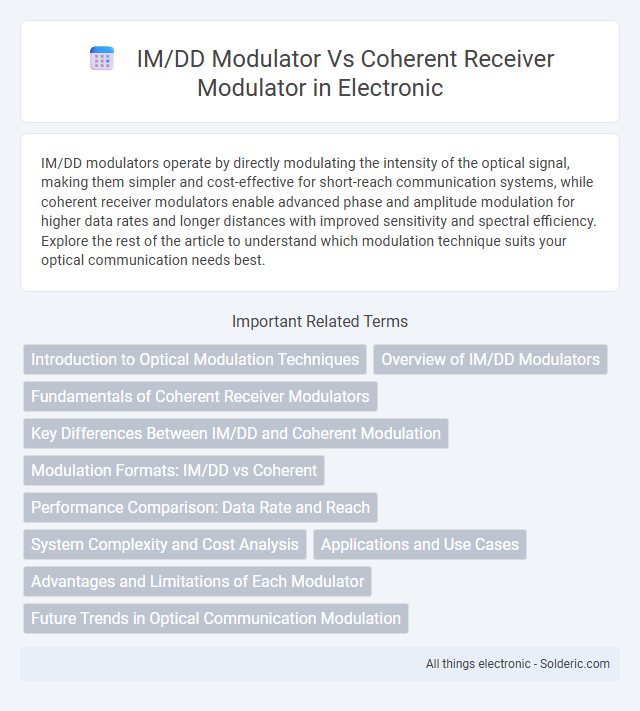IM/DD modulators operate by directly modulating the intensity of the optical signal, making them simpler and cost-effective for short-reach communication systems, while coherent receiver modulators enable advanced phase and amplitude modulation for higher data rates and longer distances with improved sensitivity and spectral efficiency. Explore the rest of the article to understand which modulation technique suits your optical communication needs best.
Comparison Table
| Feature | IM/DD Modulator | Coherent Receiver Modulator |
|---|---|---|
| Modulation Technique | Intensity Modulation with Direct Detection | Coherent Detection with Phase and Amplitude Modulation |
| Detection Method | Direct Photodetection | Phase-sensitive Heterodyne/Homodyne Detection |
| Sensitivity | Lower Sensitivity | High Sensitivity |
| Complexity | Simple and Cost-Effective | Complex and Costly |
| Spectral Efficiency | Low | High |
| Noise Tolerance | Moderate | Better Tolerance to Noise and Dispersion |
| Applications | Short to Medium-Range Optical Links | Long-Haul and High-Capacity Optical Networks |
| Signal Complexity | Intensity Only | Amplitude, Phase, and Polarization |
Introduction to Optical Modulation Techniques
IM/DD modulators employ intensity modulation paired with direct detection, offering simplicity and cost-effectiveness for short-reach optical communication systems. Coherent receiver modulators utilize phase, amplitude, and polarization modulation combined with coherent detection, enabling higher spectral efficiency and enhanced sensitivity for long-haul and high-capacity networks. Optical modulation techniques thus balance complexity, performance, and application requirements, driving advancements in fiber-optic communication.
Overview of IM/DD Modulators
IM/DD modulators encode data by varying the light intensity in direct detection optical communication systems, offering simplicity and cost-effectiveness for short-reach applications. These modulators typically employ components such as Mach-Zehnder interferometers or electro-absorption modulators to modulate the optical power without phase information. Compared to coherent receiver modulators that require complex phase and amplitude control, IM/DD modulators prioritize straightforward intensity modulation, making them ideal for data centers and access networks.
Fundamentals of Coherent Receiver Modulators
Coherent receiver modulators employ complex modulation formats such as QPSK or QAM, enabling the detection of both amplitude and phase of the optical signal for higher spectral efficiency compared to IM/DD modulators. Your communication system benefits from advanced digital signal processing (DSP) techniques in coherent receivers, which compensate for chromatic dispersion and polarization mode dispersion, significantly enhancing signal quality over long distances. These modulators require a local oscillator laser at the receiver to mix with the incoming signal, facilitating coherent detection and improving sensitivity and data capacity in high-speed optical networks.
Key Differences Between IM/DD and Coherent Modulation
IM/DD modulators employ intensity modulation and direct detection, converting optical signals directly into electrical signals without phase information, making them simpler and cost-effective for short-reach communication. Coherent modulators utilize advanced phase and amplitude modulation with coherent detection, enabling higher data rates, improved sensitivity, and robust signal recovery over long distances. Understanding these key differences helps you select the right technology for applications requiring either simplicity and cost efficiency or enhanced performance and spectral efficiency.
Modulation Formats: IM/DD vs Coherent
IM/DD modulation formats primarily utilize intensity variations of the optical signal, such as On-Off Keying (OOK) and Pulse Amplitude Modulation (PAM), enabling simpler and cost-effective implementations for short to medium distances. Coherent modulation formats, including Quadrature Phase Shift Keying (QPSK) and 16-Quadrature Amplitude Modulation (16-QAM), encode information in both the amplitude and phase of light waves, offering higher spectral efficiency and improved sensitivity for long-haul and high-capacity optical communication systems. Your choice between IM/DD and coherent modulation depends on system requirements for bandwidth, complexity, and transmission distance.
Performance Comparison: Data Rate and Reach
IM/DD modulators typically support lower data rates and shorter reach due to their simpler design and susceptibility to noise and dispersion. Coherent receiver modulators enable significantly higher data rates, often exceeding 400 Gbps, and extended reach beyond 100 km by utilizing advanced digital signal processing and phase-sensitive detection. The enhanced sensitivity and spectral efficiency of coherent systems make them preferable for long-haul and high-capacity optical communication networks.
System Complexity and Cost Analysis
IM/DD modulators feature simpler architectures utilizing direct detection, resulting in lower system complexity and reduced implementation costs suitable for cost-sensitive applications. Coherent receiver modulators employ advanced phase and amplitude modulation with intricate digital signal processing, increasing system complexity and elevating overall expenditure but delivering superior performance in spectral efficiency and sensitivity. The cost trade-off favors IM/DD for short-reach, low-budget deployments, whereas coherent systems justify their higher investment in long-haul, high-capacity optical communication networks.
Applications and Use Cases
IM/DD modulators are widely used in cost-sensitive and short-reach applications such as data centers and local area networks, where simplicity and low power consumption are essential. Coherent receiver modulators excel in long-haul telecommunications and high-capacity metro networks, providing enhanced sensitivity and spectral efficiency for demanding optical fiber communication systems. Your choice between these modulators depends on the balance between system complexity, cost, and performance requirements in specific communication infrastructures.
Advantages and Limitations of Each Modulator
IM/DD modulators offer simplicity and cost-effectiveness, making them ideal for short-reach optical communication with lower sensitivity requirements and straightforward implementation. Coherent receiver modulators provide superior spectral efficiency, higher sensitivity, and advanced modulation formats, enabling longer distance transmission and robust performance against impairments. Your choice depends on balancing these trade-offs between complexity, cost, and performance demands in optical networks.
Future Trends in Optical Communication Modulation
IM/DD modulators dominate cost-sensitive, short-reach optical communication due to simplicity but face limitations in spectral efficiency and noise tolerance. Coherent receiver modulators enable advanced modulation formats like QAM and DP-QPSK, driving higher data rates and longer transmission distances in metro and long-haul networks. Future trends focus on integration of photonic components, machine learning-assisted modulation formats, and hybrid IM/DD-coherent systems to balance performance, cost, and energy efficiency in 400G and beyond optical networks.
IM/DD modulator vs coherent receiver modulator Infographic

 solderic.com
solderic.com